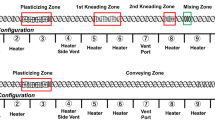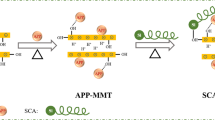Abstract
Wildfires have been recognized as a natural incident in some forests, however, fire season is now more severe and extensive, even in tropical rainforests in which fire could have damaging impacts. A hydrogel is a 3-D polymeric structure encompassing cross-linked and hydrophilic macromolecules. In comparison with water, hydrogels have shown some superiorities in terms of water-binding, cooling, and sealing, which make them be applied in forest fire prevention programs for improving fire-extinguishing performance. In this study, an environmentally friendly phosphorus-modified methylcellulose/silica hybrid hydrogel was prepared based on the modified methylcellulose by 9,10-dihydro-9-oxa-10-phosphaphenanthrene-10-oxide–itaconic acid (DOPO-ITA) and silica nanoparticles. In the fire prevention experiments, the grass treated with the methylcellulose@DOPO-ITA@silica hybrid hydrogel shows self-extinguishing behavior, whereas those treated with ordinary water or methylcellulose hydrogel can be easily ignited after one week. In the firefighting experiments, the methylcellulose@DOPO-ITA@silica hybrid hydrogel displays a much shorter extinguishing time and lower consumption volume than ordinary water and the methylcellulose@DOPO-ITA hydrogel. This work presents an environmentally friendly, non-toxic, and biodegradable cellulose-based hybrid hydrogel for the fire prevention and firefighting of wildfires.









Similar content being viewed by others
References
Adamek M, Hadincova V, Wild J (2016) Long-term effect of wildfires on temperate Pinus sylvestris forests: Vegetation dynamics and ecosystem resilience. Forest Ecol Manag 380:285–295
Chandra KK, Bhardwaj AK (2015) Incidence of forest fire in india and its effect on terrestrial ecosystem dynamics, nutrient and microbial status of soil. Int J Agric For 5(2):69–78
Tymstra C, Stocks BJ, Cai X, Flannigan MD (2020) Wildfire management in Canada: Review, challenges and opportunities. Prog Disast Sci 5:100045
Manzello SL, Almand K, Guillaume E, Vallerent S, Hameury S, Hakkarainen T (2018) The growing global wildland urban interface (WUI) fire Dilemma: Priority needs for research. Fire Safety J 100:64–66
Annual Report of the Insurance Commissioner. California Department of Insurance, (2007). http://www.insurance.ca.gov.
Teague B, Mcleod R, Pascoe S (2009) Victorian bushfires royal commission “final report summary”, 2010
Jiang WY, Wang F, Fang LH, Zheng XC, Qiao XH, Li ZH, Meng QX (2021) Modelling of wildland-urban interface fire spread with the heterogeneous cellular automata model. Environ Modell Softw 135:104895
Center for Disaster Philanthropy. 2019–2020 Australian Bushfires (2020) https://disasterphilanthropy.org/disaster/2019-australian-wildfires/
Korobeinichev OP, Shmakov AG, Shvartsberg VM, Chernov AA, Yakimov SA, Koutsenogii KP, Makarov VI (2012) Fire suppression by low-volatile chemically active fire suppressants using aerosol technology. Fire Safety J 51:102–109
Vega C, Conde MM, McBride C, Abascal JLF, Noya EG, Ramirez R, Sese LM (2010) Heat capacity of water: A signature of nuclear quantum effects. J Chem Phys 132(4):046101
Torquato S, Stell G (1981) Latent-heat of vaporization of a fluid. J Phys Chem 85(21):3029–3030
Agueda A, Pastor E, Planas E (2008) Different scales for studying the effectiveness of long-term forest fire retardants. Prog Energ Combust 34(6):782–796
Liodakis S, Tsapara V, Agiovlasitis IP, Vorisis D (2013) Thermal analysis of Pinus sylvestris L. wood samples treated with a new gel-mineral mixture of short- and long-term fire retardants. Thermochim Acta 568:156–160
Kalabokidis KD (2000) Effects of wildfire suppression chemicals on people and the environment—a review. Global Nest J 2(2):129–137
Azizi S, Mohamad R, Rahim RA, Mohammadinejad R, Bin Ariff A (2017) Hydrogel beads bio-nanocomposite based on Kappa-Carrageenan and green synthesized silver nanoparticles for biomedical applications. Int J Biol Macromol 104:423–431
Ibrahim S, Nawwar GAM, Sultan M (2016) Development of bio-based polymeric hydrogel: Green, sustainable and low cost plant fertilizer packaging material. J Environ Chem Eng 4(1):203–210
Thakur S, Chaudhary J, Kumar V, Thakur VK (2019) Progress in pectin based hydrogels for water purification: Trends and challenges. J Environ Manage 238:210–223
Kim BS, Shin YC (2007) pH-sensitive swelling and release behaviors of anionic hydrogels for intelligent drug delivery system. J Appl Polym Sci 105(6):3656–3661
Fan YJ, Zhao YY, Hu XM, Wu MY, Xue D (2020) A novel fire prevention and control plastogel to inhibit spontaneous combustion of coal: Its characteristics and engineering applications. Fuel 263:116693
Vinogradov AV, Kuprin DS, Abduragimov IM, Kuprin GN, Serebriyakov E, Vinogradov VV (2016) Silica foams for fire prevention and firefighting. ACS Appl Mater Inter 8(1):294–301
Giudice CA, Alfieri PV, Canosa G (2013) Siloxanes synthesized “in situ” by sol-gel process for fire control in wood of Araucaria angustifolia. Fire Safety J 61:348–354
Illeperuma WRK, Rothemund P, Suo ZG, Vlassak JJ (2016) Fire-resistant hydrogel-fabric laminates: A simple concept that may save lives. ACS Appl Mater Inter 8(3):2071–2077
Zhang LL, Qin BT (2014) Study on the gelation of foamed gel for preventing the spontaneous combustion of coal. J Spectrosc 2014:163742
de Dicastillo CL, Bustos F, Guarda A, Galotto MJ (2016) Cross-linked methyl cellulose films with murta fruit extract for antioxidant and antimicrobial active food packaging. Food Hydrocolloid 60:335–344
Cui XF, Zheng WJ, Zou W, Liu XY, Yang H, Yan J, Gao Y (2019) Water-retaining, tough and self-healing hydrogels and their uses as fire-resistant materials. Polym Chem 10(37):5151–5158
Chung JY, Ko JH, Lee YJ, Choi HS, Kim YH (2018) Surfactant-free solubilization and systemic delivery of anti-cancer drug using low molecular weight methylcellulose. J Control Release 276:42–49
Bai ZM, Song L, Hu Y, Gong XL, Yuen RKK (2014) Investigation on flame retardancy, combustion and pyrolysis behavior of flame retarded unsaturated polyester resin with a star-shaped phosphorus-containing compound. J Anal Appl Pyrol 105:317–326
Tang S, Qian LJ, Qiu Y, Dong YP (2018) Synergistic flame-retardant effect and mechanisms of boron/phosphorus compounds on epoxy resins. Polym Advan Technol 29(1):641–648
Patel MA, AbouGhaly MHH, Schryer-Praga JV, Chadwick K (2017) The effect of ionotropic gelation residence time on alginate cross-linking and properties. Carbohyd Polym 155:362–371
Matta E, Tavera-Quiroz MJ, Bertola N (2019) Active edible films of methylcellulose with extracts of green apple (Granny Smith) skin. Int J Biol Macromol 124:1292–1298
Zhang JH, Mi XQ, Chen SY, Xu ZJ, Zhang DH, Miao MH, Wang JS (2020) A bio-based hyperbranched flame retardant for epoxy resins. Chem Eng J 381:122719
Zohuriaan MJ, Shokrolahi F (2004) Thermal studies on natural and modified gums. Polym Test 23(5):575–579
Akakuru O, Isiuku B (2017) Chitosan hydrogels and their glutaraldehyde-crosslinked counterparts as potential drug release and tissue engineering systems-synthesis, characterization, swelling kinetics and mechanism. J Phys Chem Biophys 7(3):1–7
Acknowledgements
We gratefully acknowledge the financial support from the National Key Research and Development Program of China (Grant No. 2017YFC0805900), the Fundamental Research Funds for the Central Universities (Grant No. WK2320000047), and the USTC Research Funds of the Double First-Class Initiative (Grant No.: YD2320002004).
Author information
Authors and Affiliations
Corresponding authors
Additional information
Publisher's Note
Springer Nature remains neutral with regard to jurisdictional claims in published maps and institutional affiliations.
Supplementary Information
Below is the link to the electronic supplementary material.
Supplementary file1 (MP4 26047 kb)
Supplementary file2 (MP4 26784 kb)
Supplementary file3 (MP4 45597 kb)
Supplementary file4 (MP4 16209 kb)
Supplementary file5 (MP4 19800 kb)
Supplementary file6 (MP4 20021 kb)
Supplementary file7 (MP4 21900 kb)
Supplementary file8 (MP4 19916 kb)
Supplementary file9 (MP4 20645 kb)
Supplementary file10 (MP4 17294 kb)
Supplementary file11 (MP4 19732 kb)
Supplementary file12 (MP4 19442 kb)
Supplementary file13 (MP4 22589 kb)
Supplementary file14 (MP4 23012 kb)
Supplementary file15 (MP4 22287 kb)
Supplementary file16 (MP4 22326 kb)
Rights and permissions
About this article
Cite this article
Nabipour, H., Shi, H., Wang, X. et al. Flame Retardant Cellulose-Based Hybrid Hydrogels for Firefighting and Fire Prevention. Fire Technol 58, 2077–2091 (2022). https://doi.org/10.1007/s10694-022-01237-y
Received:
Accepted:
Published:
Issue Date:
DOI: https://doi.org/10.1007/s10694-022-01237-y




